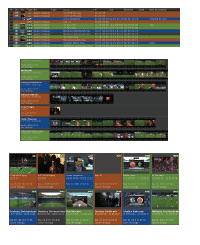
#CATDV PEGASUS ARCHIVE#
With Final Cut Pro and the need to Log & Transfer to an intermediate codec, you always had an automatic initial backup if you kept your offloads on an archive drive and your transcoded work files on your work drive. The main reason for this is Premiere Pro’s ability to work with native formats. Try also other selecting picklist instead of simple text fields.Since my recent switch from Final Cut Pro to Premiere Pro, I have had to make slight adjustments to my backup and archiving workflow. Once tested you can add more user input options by duplicating the steps above to daisy chain options. Once added press enter and the data is added to the selected fields The user input box appears requesting user data. In order to activate the custom action, select the clips you want to apply the action to and drag them towards the action and drop them onto it. Press OK to save the custom Action which will appear in the left hand view under custom actions. There is also an action to show the custom action in the tool bar, the text box to the right allows for a shot custom action name to be displayed. The ‘Allow complex clips’ option enables the action to work on complex MXF clips which are made up of separate files such as RED, Avid formatted files. These setting apply to all clips selected. There are some global options within the Custom Action that you may want to check or uncheck. There are also options for the stored variable to either append, prepend, merge to existing data stored in the Field ‘Notes’ The variable name has to match the name from the first step.

This is stored using a simple regex variable. The Value field reads the data captured from the first processing step. In this example we are saving the ‘captured’ data to the ‘notes’ field This processing step will copy the gathered data from the earlier step into your selected Field within CatDV.įrom the dropdown list next to ‘Field’ select the field you want to store the data to. You then need to add another processing step to complete the custom actionĬlick the + icon and select ‘Set Clip Field’ If you tick the ‘required box’ then there must be valid data entered by the user to complete the custom action – it would then act as a mandatory field. You can choose to add a default value if needed, this could save time during the logging stage if it is unlikely to change that often – in this example we will leave this blank. This is just a temporary name for the data being collected. We will keep the ‘Type’ set to multiline textĮnter a name for the label, this does not need to match any existing label for a user field. This displays the menu to program that step.
#CATDV PEGASUS PLUS#
To keep it simple we will just ask the user to add data to one simple text boxĬlick the plus (+) icon to create a new action step.įrom the drop down select ‘Prompt User for input’ and click Next Give a name and description to the new action. Navigate to the custom Actions panel on the left hand side, right click and select ‘New Custom Action’ The data entered by the user will be applied to all clips selected In this example we will setup a simple custom action that requests input from the user. There are many possibilities from moving files to other storage, updating metadata, transcoding or exporting files to preset formats. This provides a ‘mini style’ worker available to desktop users.Ĭustom Actions can be created using CatDV Pegasus.


Files can be pushed out from the desktop client to other areas of the network based on matching metadata. This allows repetitive tasks or file copies to be automated right from within the desktop. Pegasus Custom ActionsĬatDV Pegasus allows you to create automated actions to be used in the desktop client.

Please use the left hand menu to navigate through the pages. This section contains outline tutorials for CatDV Pegasus.


 0 kommentar(er)
0 kommentar(er)
